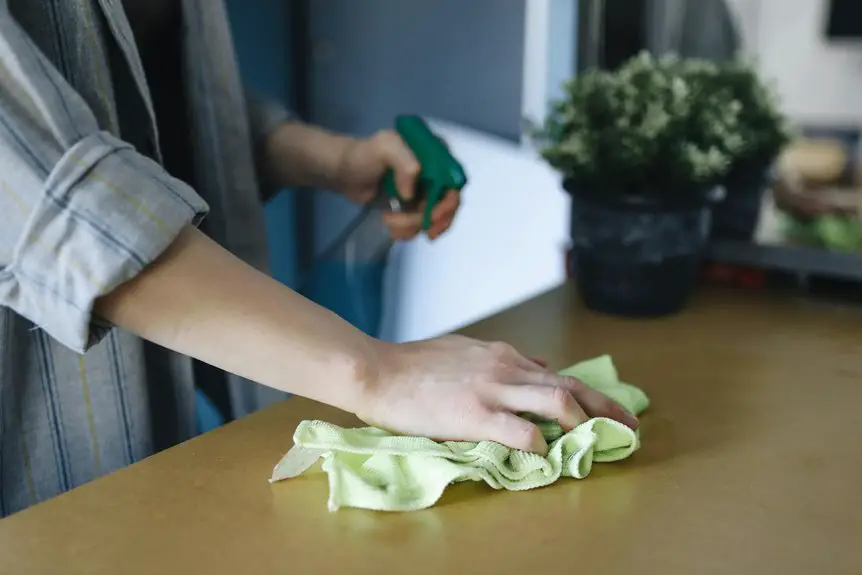Corduroy care depends on its fabric blend and manufacturer instructions. If your garment’s label says “Dry Clean Only,” it’s best to follow that to avoid damage and maintain texture. However, many corduroy items made from cotton blends can be gently hand or machine washed with mild detergent on low heat. Quick stain treatment and air drying help preserve its look. Keep going to discover detailed tips for washing, drying, and storing corduroy to keep it in great shape.
Table of Contents
Key Takeaways
- Corduroy can be dry cleaned, especially for delicate blends or heavy stains, to prevent fabric damage and maintain texture.
- Always check the manufacturer’s care label to confirm if dry cleaning is recommended or if gentle home washing is allowed.
- Light stains and minor dirt on cotton corduroy can be treated at home with mild detergent and cold water, avoiding harsh chemicals.
- Air drying corduroy flat or hung away from direct sunlight preserves its ridges and prevents heat damage from tumble drying.
- Iron corduroy inside out on low heat with a cloth barrier to avoid crushing the fabric’s nap or causing shine marks.
Understanding Corduroy Fabric Composition
Corduroy is a durable fabric characterized by its distinctive raised ridges, or “wales.” You’ll find it made primarily from cotton or cotton blends, which gives it softness and breathability.
These wales create a textured surface that not only adds visual interest but also affects how the fabric wears and cleans. The thickness and spacing of the wales vary, influencing the fabric’s weight and feel.
When you’re caring for corduroy, understanding its fiber content helps you choose the right washing methods and products. Since most corduroy contains natural fibers, it’s important to avoid harsh chemicals or excessive heat that could shrink or damage the fabric.
Knowing this composition sets a solid foundation for keeping your corduroy looking great over time.
When to Choose Dry Cleaning for Corduroy
You should consider dry cleaning corduroy when the fabric blend is delicate or mixed with materials that water can damage.
If your garment has tough stains or heavy soil, dry cleaning often handles them better than home washing.
Always check the manufacturer’s care label before deciding to guarantee you protect your corduroy piece properly.
Fabric Composition Considerations
Although corduroy is generally durable, the fabric’s blend and finish can affect how you should clean it.
If your corduroy contains delicate fibers like silk, wool, or rayon, dry cleaning is often the safer choice. These materials can shrink, distort, or lose texture when exposed to water and agitation in a washing machine.
Additionally, corduroy with special finishes—such as water-repellent coatings or intricate embroidery—may require dry cleaning to preserve those details.
On the other hand, pure cotton corduroy usually handles gentle machine washing well.
Always check the care label first; it provides essential guidance based on the specific fabric composition.
When in doubt, opting for dry cleaning helps maintain the garment’s original look and feel, especially for mixed-fiber or specially treated corduroy pieces.
Stain and Soil Level
Multiple factors determine when dry cleaning is the best option for corduroy, but one of the most important is the level of stains and soil on the fabric.
If your corduroy garment has heavy stains, like oil, wine, or ink, dry cleaning is often the safest choice because it effectively breaks down tough spots without damaging the fabric’s texture.
For light dirt or minimal staining, you can usually get away with spot cleaning or gentle machine washing.
However, when soiling is widespread or embedded deep into the fibers, dry cleaning prevents further wear and color fading.
Manufacturer Care Instructions
Evaluating stains and soil levels helps determine when dry cleaning is necessary, but following the manufacturer’s care instructions is just as important.
When you check the label on your corduroy garment, you’ll find specific guidance on cleaning methods to preserve its texture and color. If the tag says “Dry Clean Only,” it’s best to avoid home washing to prevent damage or shrinkage.
Sometimes, the label might allow gentle machine washing or hand washing, but still recommend dry cleaning for tough stains or heavy soiling. Ignoring these instructions can lead to fading, warping, or fabric weakening.
To keep your corduroy looking its best, always prioritize the manufacturer’s advice—they know the fabric’s needs better than anyone. When in doubt, dry cleaning is the safer choice.
Benefits of Washing Corduroy at Home
When you wash corduroy at home, you gain better control over the cleaning process, ensuring the fabric’s texture and color stay intact. You can adjust water temperature, choose gentle detergents, and avoid harsh chemicals that might damage the fabric. Plus, washing at home saves you money and reduces trips to the dry cleaner.
Here’s a quick look at what you gain:
| Benefit | Why It Matters |
|---|---|
| Fabric Protection | Prevents fading and wear |
| Cost-Effective | Saves on dry cleaning bills |
| Convenience | Clean whenever you want, no waiting |
Step-by-Step Guide to Hand Washing Corduroy
Before you start hand washing your corduroy, make sure to prepare the fabric properly by checking for stains and turning it inside out.
Use gentle washing techniques to protect the texture, like soaking in cool water with mild detergent and softly rubbing any spots.
Finally, follow proper drying methods by laying the fabric flat or hanging it to air dry, avoiding direct heat.
Preparing Corduroy Fabric
Although corduroy is sturdy, treating it gently during washing preserves its texture and color.
Before you start hand washing, preparing the fabric properly is essential. First, check for any stains and spot-treat them with a mild detergent—you want to handle those before soaking.
Second, turn your corduroy garment inside out to protect the raised ridges from friction and fading.
Third, fasten any buttons or zippers to prevent snags during washing. Taking these steps shows your care and respect for the fabric, ensuring your corduroy looks great for longer.
Gentle Washing Techniques
A careful approach to hand washing corduroy helps maintain its unique texture and vibrant color.
Start by filling a basin with lukewarm water and adding a mild detergent designed for delicate fabrics. Submerge your corduroy item gently, avoiding any harsh scrubbing. Swish it around softly for a few minutes to loosen dirt.
Next, rinse thoroughly with cool water until all soap is gone. To remove excess water, press the fabric gently between towels—don’t wring or twist, as this can damage the fibers.
If your garment has stains, pre-treat them by dabbing a small amount of detergent directly on the spot before washing. Following these steps guarantees your corduroy stays soft and looking fresh without risking damage from aggressive cleaning methods.
Proper Drying Methods
Once you’ve gently washed your corduroy, drying it properly is essential to preserving its texture and shape. Avoid wringing out the fabric, as this can distort the ribs and cause wrinkles.
Instead, follow these steps:
- Lay your corduroy flat on a clean, dry towel.
- Roll the towel and garment together to absorb excess water gently.
- Unroll and reshape the corduroy, smoothing out any creases to maintain its natural look.
- Air dry the garment flat or hang it on a padded hanger in a well-ventilated area, away from direct sunlight or heat sources which can fade colors and damage fibers.
Machine Washing Corduroy: Tips and Precautions
Since corduroy’s textured fabric can easily trap dirt and oils, you’ll want to machine wash it carefully to maintain its appearance and softness.
Turn your corduroy garment inside out to protect the raised ridges and reduce friction. Use cold water with a gentle cycle to prevent shrinking and preserve the fabric’s texture.
Avoid overloading the washing machine, so the fabric has enough room to move freely without excessive rubbing. Choose a mild detergent designed for delicate fabrics, and skip bleach or harsh chemicals that can damage the fibers.
After washing, avoid wringing or twisting the fabric, which can distort its shape. Following these precautions will help your corduroy stay vibrant and comfortable through multiple washes.
How to Remove Stains From Corduroy
While washing corduroy carefully helps maintain its look, stains can still happen and require prompt attention.
Even with careful washing, corduroy can stain and needs quick, gentle care to keep its appearance.
To tackle stains effectively, follow these steps:
- Act fast: Blot the stain gently with a clean cloth to absorb as much as possible without rubbing, which could damage the fabric’s nap.
- Spot clean: Mix mild detergent with water and apply it using a soft brush or cloth, working with the corduroy’s texture to lift the stain.
- Rinse and air dry: Use a damp cloth to remove detergent residue, then let the garment air dry away from direct heat to preserve its feel.
Best Practices for Drying and Ironing Corduroy
Although corduroy is a durable fabric, improper drying and ironing can easily damage its distinctive texture.
To keep your corduroy looking sharp, air-dry it whenever possible. Lay the garment flat or hang it to dry away from direct sunlight to prevent fading. Avoid using a tumble dryer, as the heat can crush the pile and cause shrinkage.
When ironing, turn the garment inside out to protect the ridges. Use a low heat setting and press gently, avoiding heavy pressure that can flatten the fabric’s nap. If needed, place a thin cloth between the iron and corduroy to prevent shine marks.
These simple steps guarantee your corduroy stays soft, vibrant, and maintains its classic look for years.
Storing Corduroy Garments to Maintain Their Shape
To keep your corduroy garments looking their best, you need to store them properly to maintain their shape. Hanging corduroy can cause stretching or misshaping, so it’s best to fold these pieces carefully.
Here’s how you can do it right:
- Fold Along Seams: Fold your corduroy garments along the seams to avoid creases that can damage the fabric’s texture.
- Use Breathable Storage: Store them in breathable cotton bags or containers to protect from dust while allowing air circulation, preventing mustiness.
- Avoid Heavy Stacking: Don’t pile too many items on top of each other—corduroy can get crushed, losing its distinctive ridges and shape.
Frequently Asked Questions
Can Corduroy Shrink After Washing?
Think of corduroy like a sponge—it can shrink if you’re not careful. You’ll want to wash it in cold water and avoid high heat drying to keep it fitting just right and looking sharp every time.
Is It Safe to Bleach Corduroy Fabric?
You shouldn’t bleach corduroy fabric because it can damage the fibers and ruin its texture. Instead, spot clean stains gently and use mild detergent when washing to keep your corduroy looking great and lasting longer.
How Does Corduroy Fabric Wear Over Time?
You know what they say, “Rome wasn’t built in a day.” Corduroy wears well over time but softens and shows slight fading. If you treat it gently, you’ll keep its texture and rich look longer.
Are Corduroy Clothes Hypoallergenic?
Corduroy isn’t inherently hypoallergenic, but you’ll find it generally gentle on skin. If you’re sensitive, choose natural fibers and keep your corduroy clean to reduce allergens like dust mites and irritants that might cause reactions.
Can Corduroy Be Used for Upholstery?
You can definitely use corduroy for upholstery since it’s durable and adds texture. Just remember, it might wear faster in high-traffic areas, so choose thicker cords and maintain it by regular cleaning to keep it looking great.
- Does Chiffon Fabric Stink - July 15, 2025
- Does Chiffon Fabric Affect the Economy - July 15, 2025
- Does Cotton Fabric Have a Nap - July 15, 2025






